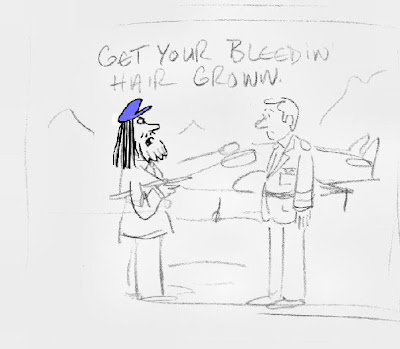I gave up cartooning, about ten or fifteen years ago, and went into academia, principally to brush up on my writing skills - such as they are - but also because I felt a need for something else. In retrospect it was probably something as obvious and fundamental as a need to mix with people who weren't particularly interested in cartooning. No, that's not really true, I'm covering my backside there, but as this is just between us I can be completely honest; what I felt then was that cartooning was both pointless, and not a very sensible job for an adult. I felt I needed to do more, and that I needed to specialize in something to be able to do so. I chose Art and enrolled in what would become a lifelong learning programme.
I've been lucky, though, I think. I've been taught, through the Open University, by people like
Tim Benton, Angus Calder,
Arthur Marwick,
Lizbeth Goodman, and many, many, others, and through them I've met poets like
Jack Mapanje and
Jackie Kay (who broke my clock), and some of the hardest working students, of all ages, sizes, shapes, and colours. When I went on to university for a second degree I was lucky to be there when
Nicholas Royle was teaching English Lit, and Literary Criticism, and when
John Burnside was there to sharpen up my challenged penmanship.
So, I suppose you're wondering out loud, what made you go back to cartooning? Well, I'm glad you asked because there are two answers to this; the first is because my son was going to Switzerland on a Rudolf Steiner School exchange and he wanted a new pair of enormous trainers for his size 12 feet, and I got back into it for extra lolly. The other reason is that I was inspired back by some of the brilliant work I discovered online, and in books. I mean, over all those years away I kept up with stuff, I bought Punch and Private Eye and the New Yorker and the like, but I never saw anything new or brilliant in the shrinking world of gag cartooning that lit my fuse. What I did discover and rediscover though was the work of Robert Crumb, and Charles Burns and Peter Bagge and Dan Clowes.
It was this new type of graphic novel, like Ghost World, or even the old type with comic collections like Bagge's Hate, a literate package of words and pictures that brought me back in. You see I'd been drawing and doing a tiny bit of writing but I wanted to do more, so I studied Art History and then I went on to study English Literature and I think that I had progressed so much as a reader, as a consumer of texts, that what I did had become very, very unchallenging to me, very disappointing, and I couldn't see any way to make it better. But here it was, this new thing, this old thing made new, repacked and remade; here was a symbiosis of art and text that was more than comics had so far been, it was, and I felt that with a growing string of letters after my name that I was now in a position to recognise it, literature that blurred the persistent boundary between low and high art. I had found cartooning I liked, that I could try to do, and that I had an understanding of and could put into words what I liked about it and why.
I suppose what I'm getting at is this. Just because you can draw cartoons doesn't mean you should. I drew cartoons as a job, as a way to make money, and it eventually became just what it sounds like, a daily chore, a grind. I didn't go away and have a Proustian or Joycean epiphany or anything like that, I just did what I hadn't done when I was younger; I learned about life and read a few books and introduced myself to more influences and quietly matured. When I finally sat down in front of a sheet of paper again I had grown up. That was something I couldn't do while I was younger.
So, and this is a purely personal list, here are some books you might want to look at if, like I did, you feel your pencil is beginning to droop (I've added some newer ones, of course):
Charles Burns: Skin Deep, Big Baby, Black Hole, et al.Dan Clowes: Ghost WorldHarvey Pekar: American Splendour, etc.Peter Bagge: Buddy Bradley and Hate, and everything elseArt Speigelman: MausRobert Crumb (a safe introduction would be something with Bob and Harv's Comics (Robert Crumb's work on American Splendour) in it. But then everything, if you can get it.Now obviously you can add
Joe Sacco and
Marjane Satrapi and
Renee French and others to this list but these are the texts that sucked me back in and I'd certainly recommend them if you ever find yourself in the same place I did.








